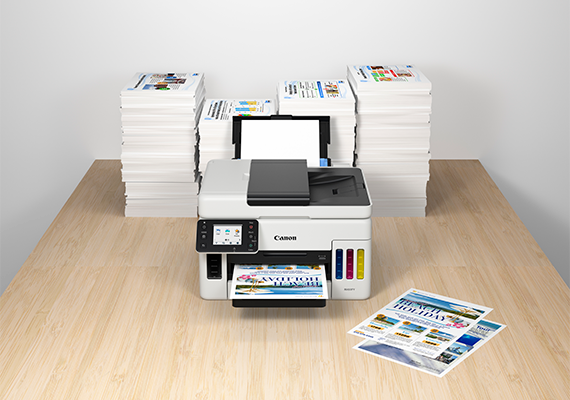Canon’s latest super tank printers have been a favourite amongst small & medium-sized business users. Keeping this demography as the main focus point, Canon has introduced its MAXIFY GX6070 series with a lot of ink, enough for around 6000 mono and 14000 colouring pages.
Moreover, this printer can print on various textures and print surfaces and ensures businesses do not need to buy different printers when there is a need to switch between envelopes, labels, glossy paper, and banner paper. Equipped with an ADF (Automatic Document Feeder), it can easily hold up to 100 documents at a time to process. Also, the convenience of not just printing but even scanning, copying and faxing makes it a versatile all-rounder printer to have.
How are the overall Design and Build quality?
Weighing close to 11.6kgs, it definitely isn’t a small device which restricts its portability, knowing that a printer’s placement is hardly changed in a corporate environment. The white boxy look is pretty contemporary with room for 250 sheets in the main paper tray, 100 sheets in the tray at the rear and another 100 sheets in the ADF.
It is sturdy and well-built with a tiltable touchscreen to control all its functions. The translucent ink tanks are large enough to hold a substantial amount of ink, which eliminates downtime as compared to its cartridge alternative. Even the paper output tray is comparatively larger than usual and is capable of holding 100 sheets of paper.
How well is the Connectivity?
A USB Host port has been given for walk-up printing from a flash memory drive, which is a convenient option, but this printer has built-in Wi-Fi, broadening its connectivity horizons. It misses out on an NFC module but is compatible with all of the popular wireless protocols such as Apple AirPrint, Wireless Direct, Mopria and of course Canon’s own PIXMA Cloud Link. It also works with Google Assistance and Amazon Alexa, but the most I enjoyed most was by printing directly using my smartphone and being connected via wi-fi to the printer. What makes the Canon Maxify, even more, user-friendly is the tilting touchscreen which offers quick and easy access to the printer’s host of features.
What’s the Performance like?
The Canon MAXIFY GX6070 surpassed our expectations without any paper jams or misprints. It’s printing speed is quite quick when printing just in black and white. It functions quietly too at just 49dB. Printing monochrome pages like that of a textbook, look consistently sharp and crisp.
Colour documents and photos on photo paper also appear clean and unblemished by horizontal lines or any other disturbances. However, higher resolution images with too much detail, colour and shadows can look grainy, even at the highest print quality.
Should you consider it?
There’s not much to pin-point about the Canon MAXIFY GX6070. It is well built, user-friendly, comprehensively feature packed and has an all-rounded performance which packs enough for domestic or business purposes. The icing on the cake is those big refillable ink tanks which can store a generous amount of ink, which eliminates the need for you to buy more for a long time. And when you do happen to excruciate every drop of it, you’ll be pleasantly surprised by the cost of the bottled ink and the price you pay per print. For its price, yes, it’s high for an inkjet printer in today’s scenario, but you’ll end up saving money in the long term.
Reasonable: Cost of printing and connectivity
Bad: Form factor is obsolete
Ugly: High price for an ink tank printer
Rating: 3.5 star
Price: Rs.48,000 /- ( Approx as online )
Specifications :
- Print, Scan, Copy
- ISO standard print speed (A4): up to 24.0 images per minute black / 15.5 images per minute colour
- Wireless, Wired LAN, Mopria, AirPrint, Direct Wireless
- Recommended monthly print volume: 300 to 2 500 pages (A4 (21.0 x 29.7cm))
